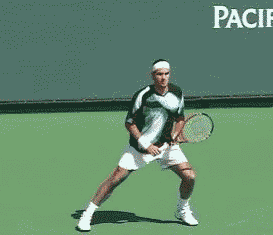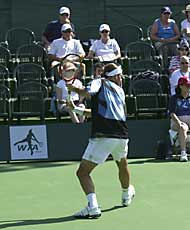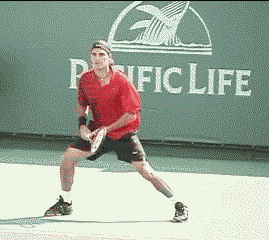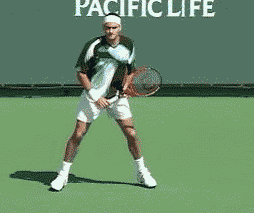|
TennisOne Lessons
Analyzing ProStrokes: Roger Federerby Jim McLennan
Elegant, flowing groundstrokes, pinpoint accuracy, topspin, backspin, sidespin. Disguise rather than power on the serve, one handed topspin backhand reminiscent of Sampras or even more so of Laver. Quick instead of powerful movements on the court. Flowing rather than muscular hits, intelligence, volleys, all the things we love to watch. All the things we miss from the game when two uninspired baseliners (yes Andy I apologize but somehow your game shows little awareness of the dimensions of the court and perhaps Gilbert can work some miracles here) slug it out, eschewing placement for power, and court position for topspin. And no, Hewitt doesn't have to change his style. But I much prefer the feeling I get from Federer's musical game, than the feeling I get from the grinding one note melodies played by Hewitt. And they may have a barnburner of a match at this years US Open, lets wait and see. And though Federer certainly will not change the legions of grinders out there, but there may be a few youngsters using videos of Edberg, McEnroe and Sampras, and who now watch Federer to guide their imagination.
Roger was born August 8th, 1981 in Basel Switzerland, He is 6'1", weighs 177 lbs, he turned pro in 1998. As of July 10th, he has 53 matches and lost 10 in the 2003 season. He holds five singles titles and one doubles title. This year he has won $1,963,359 and his career earnings are $5,700,687. The tournaments he has won this year include: Marseille, Wimbledon, Halle, Munich and Dubai, he was a finalist at Rome and Gstaad. In the event he plays a big match with Hewitt at the US Open, his record against Hewitt is 2 - 6. The most recent is in Shanghai 2002 losing on a hard court 5-7, 7-5, 5-7, at the 2002 Paris indoors on carpet he lost Looking at his match statistics to date, we see an all around player with excellent results in nearly all of the categories the ATP tracks:
Lets walk through the Federer pro strokes gallery, with an overview of what to look for, what to appreciate, and perhaps what to model. Note these observations target the mortals among us, who may never hit the ball as well as Federer, but who still try to improve their games. But in that vein, my observations are going to be simple, noting general postures and so forth as opposed to intricate details. The Federer ForehandViewing Federer's basic forehand - There are instances where he steps in to whip a winner, where he follows his shot to the net, where he plays crosscourt or down the line. But for now, let's focus on the basic, neutral forehand. Note how he positions his left arm as he prepares, how he loads the body weight on the back leg, and how he trains his eyes on the ball. He is absolutely locked on to the ball. Finally, his racquet flashes up and through contact, his arm does not finish all that high, and his body is somewhat still during this topspin drive. That is what he does. Now as to how this might feel to you and me. Try and swing the racquet continuously and loosely, not from the wrist but from the hips. As the racquet approaches the ball, feel the racquet and not the arm pop up and through the hit. Allow rather than force the racquet to finish up and over the shoulder. This occurs because of relaxation not muscle.
The Federer BackhandLook closely at Federer's basic topspin backhand. Note how he changes the grip as he turns. His arms are well away from his body and he has a simple but pronounced shoulder turn. His stroke is smooth and continuous as he powers through the ball. This is classic Rod Laver, with the signature whippy finish. So how do we mortals do this one? Turn early, relax the arms, change to an eastern grip, and swing the racquet (more than the arm) up and through the hit. You must commit to topspin on each and every swing. As a 12-year-old student, my first coach Blackie Jones showed me an eastern backhand grip (similar to Fededer's) and asked to me to use that grip on each and every drop hit whenever I started rallies. Your comments are welcome. Let us know what you think about Jim McLennan's article by emailing us here at TennisOne.
|
|||||||||||||||||||








